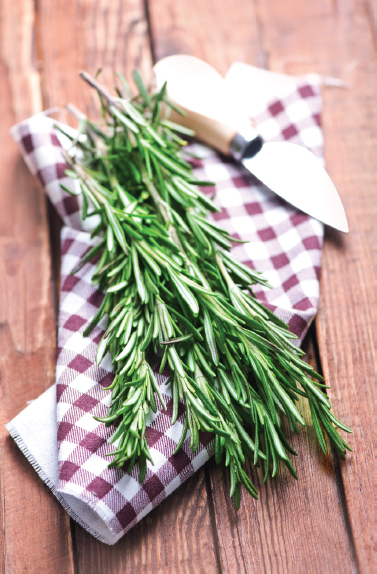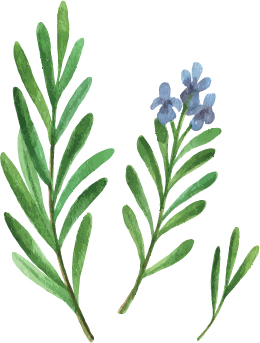

The Plant
Rosemary is a bushy little evergreen-like shrub that grows to be about two feet tall during the warm months in a temperate climate. Although it is a perennial, rosemary needs special care and covering to survive frost, and it seldom weathers temperatures in the teens (°F) or below.
Its needle leaves are silvery green; there are many varieties, with equally varied shades of gray and green.
The Flavor
Rosemary is piney, pungent, and gently peppery. Its aroma spins together balsam, resin, and fresh sea breezes. Its flavor and smell have strength and persistence.
Growing Needs
Belying the power of its aroma and flavor, rosemary can be a finicky plant to grow. It thrives in full sun and well drained soil. In fact, it prefers drier soil, although if its roots and stalks become too dry, it is impossible to revive the plant. It grows best in an alkaline soil; fertilize sparingly.
You will likely be a happier herb gardener if you begin with a rosemary plant, rather than with seeds (which may seem reluctant to germinate and grow). But watch for bugs and mites if you bring a plant home from a nursery.
Mist the leaves regularly, and you’ll dismay the bugs and encourage the plant.
Clip the stems before they get woody. Keep fresh sprigs in plastic bags in the refrigerator, or stand the stems in a jar of water.
Storage
If you want to use fresh rosemary, lay an entire sprig over a roast or a dish of sliced potatoes as you put them in the oven to bake.
If you want fresh rosemary leaves to flavor a drink, tie them up in a cheesecloth bag and put that into the pot. That saves fishing out individual leaves later, or risking swallowing the tough, scratchy needles.
You can also finely chop the fresh leaves, or crush them with a mortar and pestle, just before you are ready to stir them into a dish.
Dry sprigs by hanging them up to dry in a warm, moisture-free place. Or spread sprigs out on a screen to dry. Shake the dried needles into a bag, and then place them in an airtight container.
Crush the dried needles, also, or remove them from food before serving it.
Culinary Suggestions
Rosemary is not timid, so it needs a robust taste partner. It does wonderful things to hearty vegetables (beets and cabbage), bland vegetables (potatoes and beans), stuffings for pork or poultry, and to strongly flavored fish, to meat you want to roast or grill, and especially to lamb. Stir into soups or jellies; steep it for tea.

Distinguishing Qualities
Keep your rosemary stems, even when they’ve grown woody. Toss them into the coals in your grill; they will add flavor and aroma to whatever is roasting above.
Strip the stems of all their leaves except for a plume at one end and then use the stems as skewers to hold vegetables and tender cuts of meat. Broil the kabobs.
Tips
This powerful herb can behave delicately. Add a pinch of crushed rosemary to bread dough. Lay a fresh branch of the plant on the top of whatever you’re grilling. It will leave its piney flavor in whatever you cook.